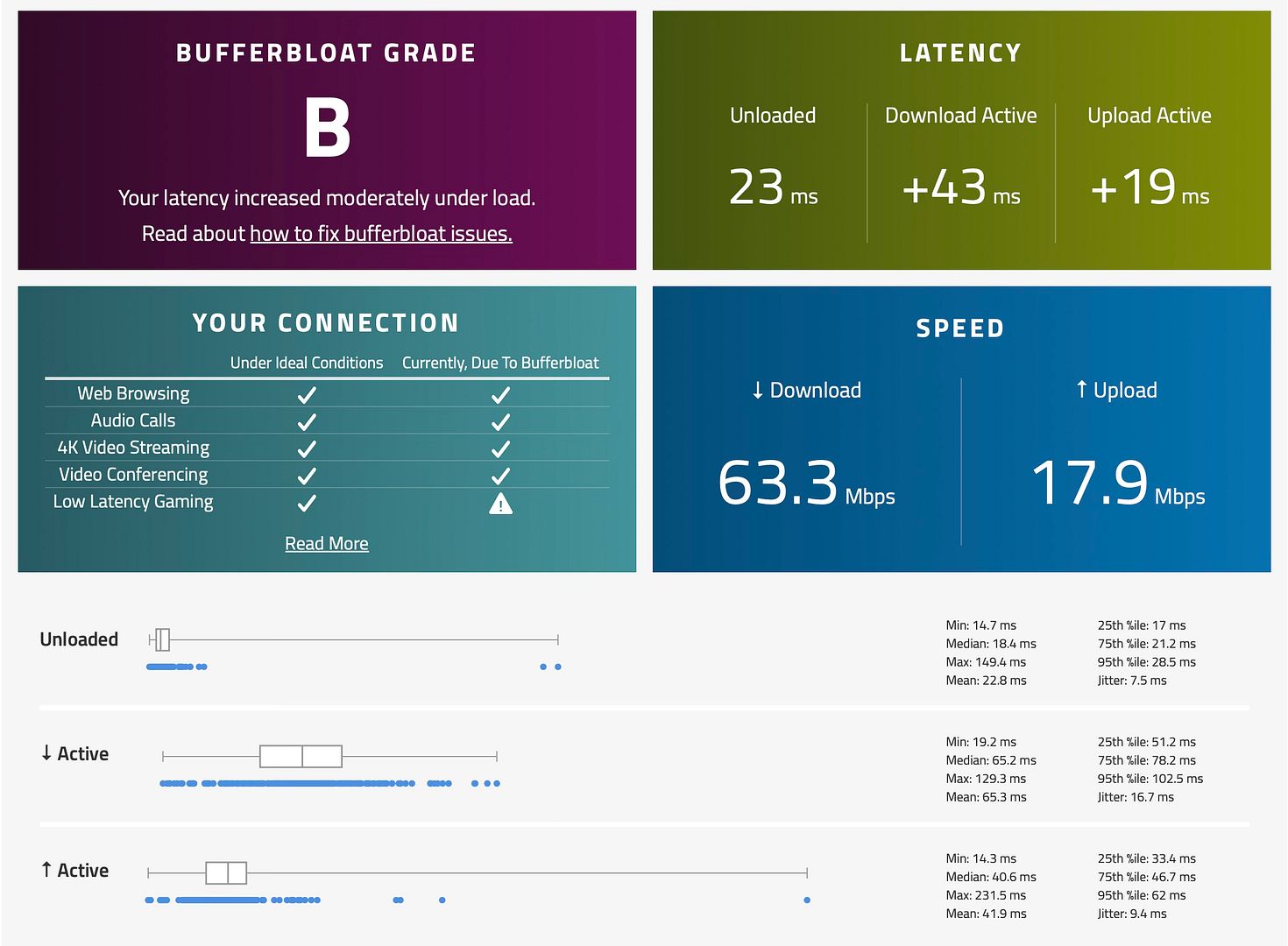Post by MartinT on May 7, 2024 17:16:47 GMT
Inspired by a thread on PFM that MikeMusic pointed me to, TonyL writes about a utility called Bufferbloat which I had not come across before. It measures the latency variation of data packets received and got me thinking about how streaming works and what is needed for optimum performance. I think this could be of even more use to those of us who stream from a 4G/5G connection rather than landline-based internet. Let me explain.
The reason I prefer streaming sound quality of 4G/5G based streaming over land-based is that it's less noisy - noise is disastrous for any digital playback system. Yes, superimposed noise causes more damage to a digital feed than an analogue one, the exact opposite of what many people think. There is a downside, however: there is more latency and weird timing issues in 4G/5G than there is in land-based internet as a rule.
I ran Bufferbloat on both my music system feed (4G+ from EE) and my main house feed (4G+ from Three) and they both score a poor grade 'F' for suffering from loads of latency under load. So far, so very expected, and I'm only interested in my music room feed quality for Qobuz streaming. I started to think about how I could improve latency and the obvious answer, although it's always been a bit of a bugger to configure, is QoS (Quality of Service), which is another way of saying traffic shaping or setting priorities.
Into the router (a TP-Link MR600) I go, to see what is available. The TP-Link has its GUI menu at...
...but other brands are all over the place. Not all routers even have a QoS setting and some make it difficult to configure. However, TP-Link gave me yet another reason to like their routers with a rather nice QoS settings page in the Advanced menu.
So what I wanted to achieve is to give my Signature Rendu Deluxe streamer a nice clean high-priority feed with nothing else able to grab packets when the streamer wants more. The way this works is you have to give QoS some parameters to work with, particularly an upload and download bandwidth which are slightly less than the actual bandwidth (which you can measure using Speedtest). I get 57Mbps download and 3.5Mbps upload. You also need to adjust the priority sliders to suit the application. I decided on 60% (the highest priority) for the Rendu, and 30% for the tablet controller. Everything else gets the remaining 10% plus a bit (the difference between the allocation and maximum).
My router settings look like this...

Results - Measurement
Using Bufferbloat again after implementing QoS, the latency grading moved from 'F' to 'A'. Impressive!

Results - Listening
Listening to the system with QoS enabled, I hear an immediate improvement in stability and rock-solid playback. I am also getting none of the occasional glitches at the start of a track, presumably because QoS is lining up the packets to feed to the Rendu so the tablet (and other devices) must wait a fraction of a second longer.
Well, I didn't expect to actually hear a difference, it comes as a real surprise. Thanks to TonyL for the inspiration.
i would love to hear from any members doing this - please publish results before and after and any screenshots you like. Please don't ask me for help with your router, though, they're all different and you'll have to sort that out for yourself.
The reason I prefer streaming sound quality of 4G/5G based streaming over land-based is that it's less noisy - noise is disastrous for any digital playback system. Yes, superimposed noise causes more damage to a digital feed than an analogue one, the exact opposite of what many people think. There is a downside, however: there is more latency and weird timing issues in 4G/5G than there is in land-based internet as a rule.
I ran Bufferbloat on both my music system feed (4G+ from EE) and my main house feed (4G+ from Three) and they both score a poor grade 'F' for suffering from loads of latency under load. So far, so very expected, and I'm only interested in my music room feed quality for Qobuz streaming. I started to think about how I could improve latency and the obvious answer, although it's always been a bit of a bugger to configure, is QoS (Quality of Service), which is another way of saying traffic shaping or setting priorities.
Into the router (a TP-Link MR600) I go, to see what is available. The TP-Link has its GUI menu at...
http://192.168.1.1...but other brands are all over the place. Not all routers even have a QoS setting and some make it difficult to configure. However, TP-Link gave me yet another reason to like their routers with a rather nice QoS settings page in the Advanced menu.
So what I wanted to achieve is to give my Signature Rendu Deluxe streamer a nice clean high-priority feed with nothing else able to grab packets when the streamer wants more. The way this works is you have to give QoS some parameters to work with, particularly an upload and download bandwidth which are slightly less than the actual bandwidth (which you can measure using Speedtest). I get 57Mbps download and 3.5Mbps upload. You also need to adjust the priority sliders to suit the application. I decided on 60% (the highest priority) for the Rendu, and 30% for the tablet controller. Everything else gets the remaining 10% plus a bit (the difference between the allocation and maximum).
My router settings look like this...

Results - Measurement
Using Bufferbloat again after implementing QoS, the latency grading moved from 'F' to 'A'. Impressive!

Results - Listening
Listening to the system with QoS enabled, I hear an immediate improvement in stability and rock-solid playback. I am also getting none of the occasional glitches at the start of a track, presumably because QoS is lining up the packets to feed to the Rendu so the tablet (and other devices) must wait a fraction of a second longer.
Well, I didn't expect to actually hear a difference, it comes as a real surprise. Thanks to TonyL for the inspiration.
i would love to hear from any members doing this - please publish results before and after and any screenshots you like. Please don't ask me for help with your router, though, they're all different and you'll have to sort that out for yourself.










